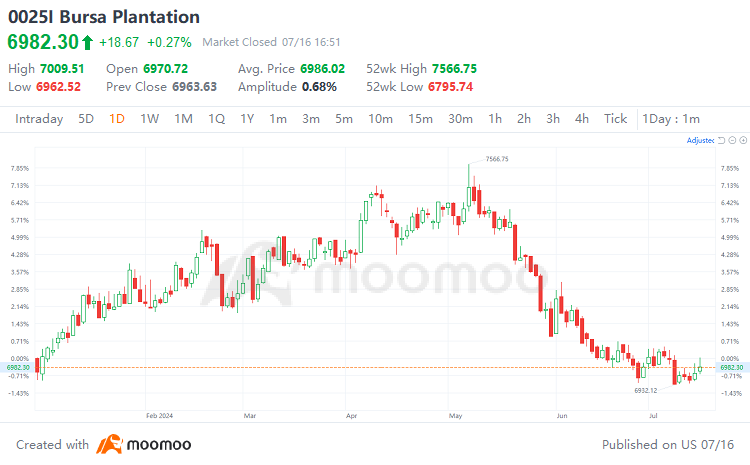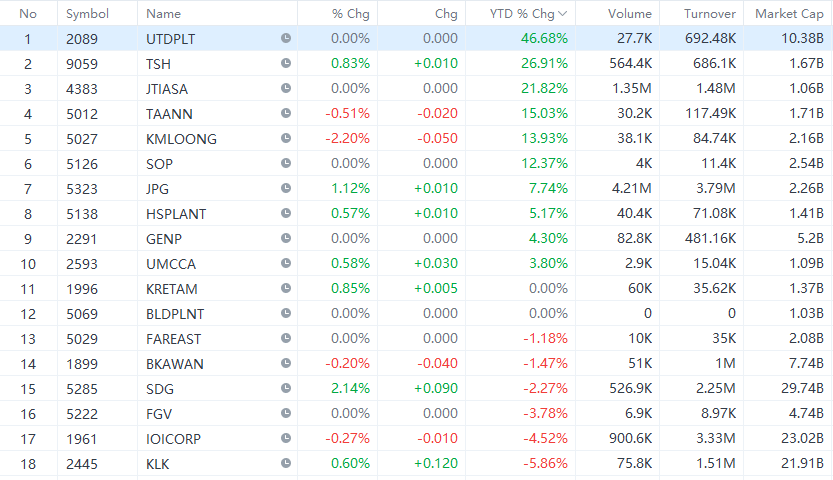La Niña Phenomenon Raises Palm Oil Supply Risks: Could It Boost Prices? Analysts Divided
Recently, Malaysia obtained palm oil trade agreements worth more than 230 million ringgit at the 15th China International Edible Oil Industry Expo held in Nanjing, China.
In addition, Malaysian palm oil companies and enterprises signed four memorandums of understanding (MoUs) at an event held on July 11, including using Taobao to develop online B2B and B2C sales channels, and using tocotrienols (a potent form of vitamin E extracted from palm oil) to enter the health product market.
What's more, Malaysia's industry regulator stated last week that palm oil stocks in Malaysia surged to a four-month high in June due to export volumes being lower than production. The increase in stocks put pressure on benchmark futures, which fell more than 4% in the two days after the data was released.
The National Grain and OilInformationCenter pointed out that due to the large increase in production in the second quarter, the growth rate is expected to slow down in the third quarter, and the increase in palm oil production in July may be within 10%. As prices fell, palm oil exports in July showed a significant improvement, with shipping survey data showing a month-on-month increase of 82.1% to 85.9% in early July. It is expected that palm oil stocks in the producing areas will continue to rise in July, but the rate of accumulation may slow down.

As the worst-performing sector in the first half of 2024, the plantation sector was the only sector to decline, falling 0.4%. The index witnessed a significant decline since May. Investors are closely watching how the palm oil market in Malaysia, the world's second-largest palm oil producer after Indonesia, will perform in the future.
La Niña Phenomenon Brings Supply Risks, Palm Oil Prices Likely to Continue Rising in the Second Half of 2024
According to a survey, the average price of palm oil in 2024 is 3,960 ringgit. According to Bloomberg's survey, the benchmark palm oil futures price in Malaysia will reach 4,000 ringgit per ton by the end of this year. This will make them expected to achieve their first annual increase since 2021.
The Malaysian Palm Oil Association (MPOA) stated this week that the average price of Malaysian benchmark crude palm oil futures is expected to be between 3,850 ringgit and 4,000 ringgit per metric ton (823.53 USD to 855.61 USD) this year, slightly higher than the average price of 3,800 ringgit per ton in 2023.
However, some institutions maintain their original palm oil price forecasts.
Maybank Investment Bank stated in a report that unless there are any unexpected weather conditions, especially in the Northern Hemisphere, palm oil prices in the second half of the year may weaken compared to the first half, as the supply of palm oil and oilseeds will increase seasonally. The bank maintains its forecast of an average selling price of 3,700 ringgit per ton for crude palm oil in 2024. It also stated that the increase in palm oil stocks may continue until October/November, coinciding with the seasonal peak production cycle.
RHB Investment Bank maintains its assumptions for crude palm oil prices in 2024-2025, at 4,000 ringgit per ton and 3,800 ringgit per ton, respectively. The institution stated that the upward trend in palm oil stocks may continue until July, as the planting pattern will continue to rise seasonally, which may offset the potential increase in export demand due to the enhanced price competitiveness of palm oil compared to soybean oil and the lack of holiday-driven demand.
Kenanga Research predicts that due to the lag in supply growth compared to demand growth, crude palm oil prices will remain strong, with an average price of 3,800 ringgit per ton in 2024. The research firm pointed out that palm oil prices usually strengthen in the first quarter, then gradually fall each quarter until the third quarter, which is often the weakest quarter in terms of prices but is also the best quarter for palm oil production. The company stated that with the end of the South American soybean harvest, crude palm oil prices in the third quarter should fall.
Which companies are worth paying attention to?
There are many companies worth considering for investment in the palm oil and plantation sector. The following are companies with a market capitalization of over RM 1 billion in this sector.
Among them, $UTDPLT (2089.MY)$ has the highest increase so far this year, rising by over 46%, followed closely by $TSH (9059.MY)$ and $JTIASA (4383.MY)$, with annual increases of over 20%.

Mooers, what is your view on the future of palm oil prices? Which company's prospects do you prefer? Please leave your comments in the comment~
Source: The Edge Malaysia, Bloomberg, moomoo
Disclaimer: Moomoo Technologies Inc. is providing this content for information and educational use only.
Read more
Comment
Sign in to post a comment

PAUL BIN ANTHONY : very helpful thanks
104138715 :![undefined [undefined]](https://static.moomoo.com/nnq/emoji/static/image/default/default-black.png?imageMogr2/thumbnail/36x36)
102377918 : well
Nestor07 :
On Paris : Thank you
Dinie Hamdan : ok